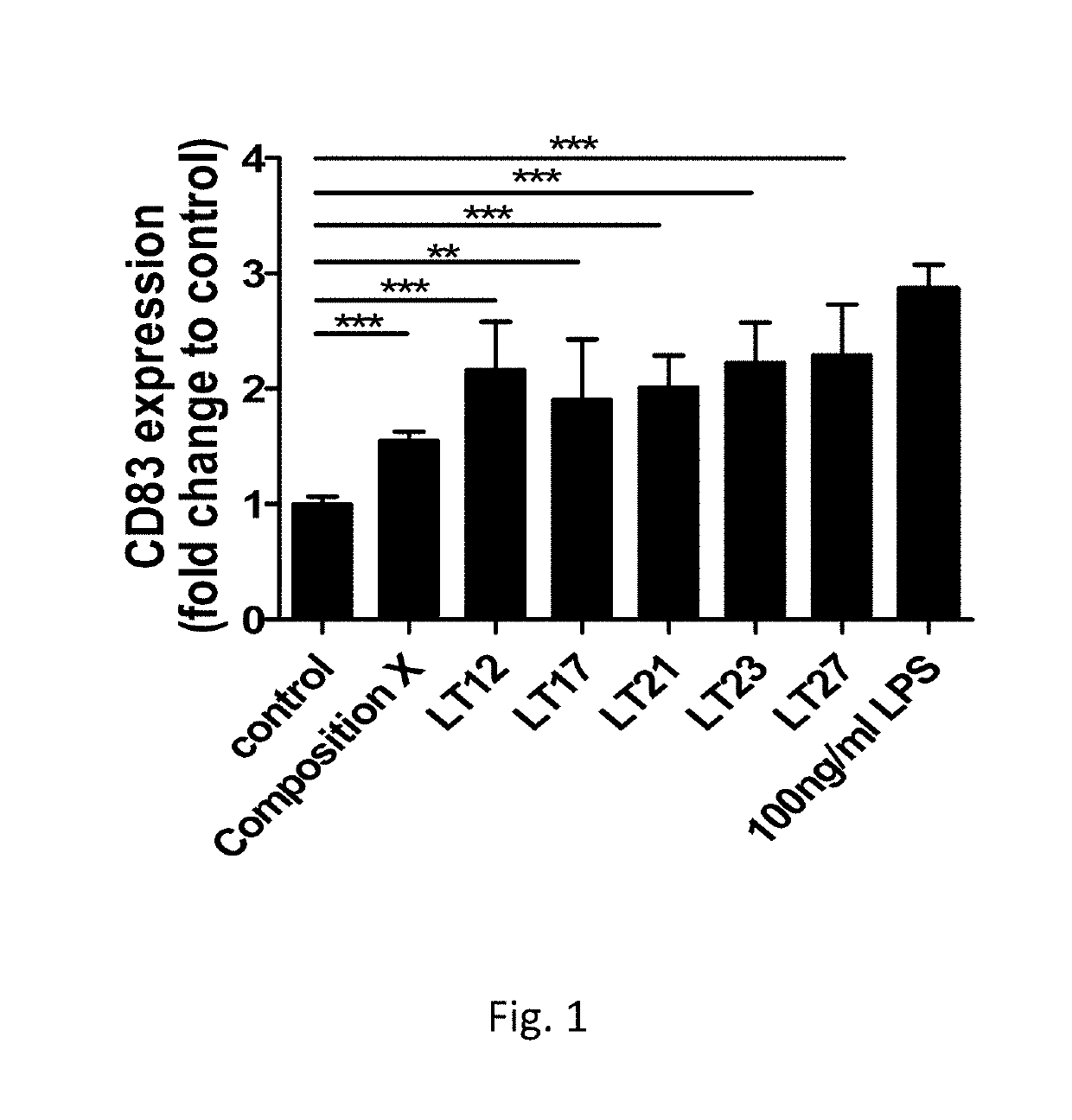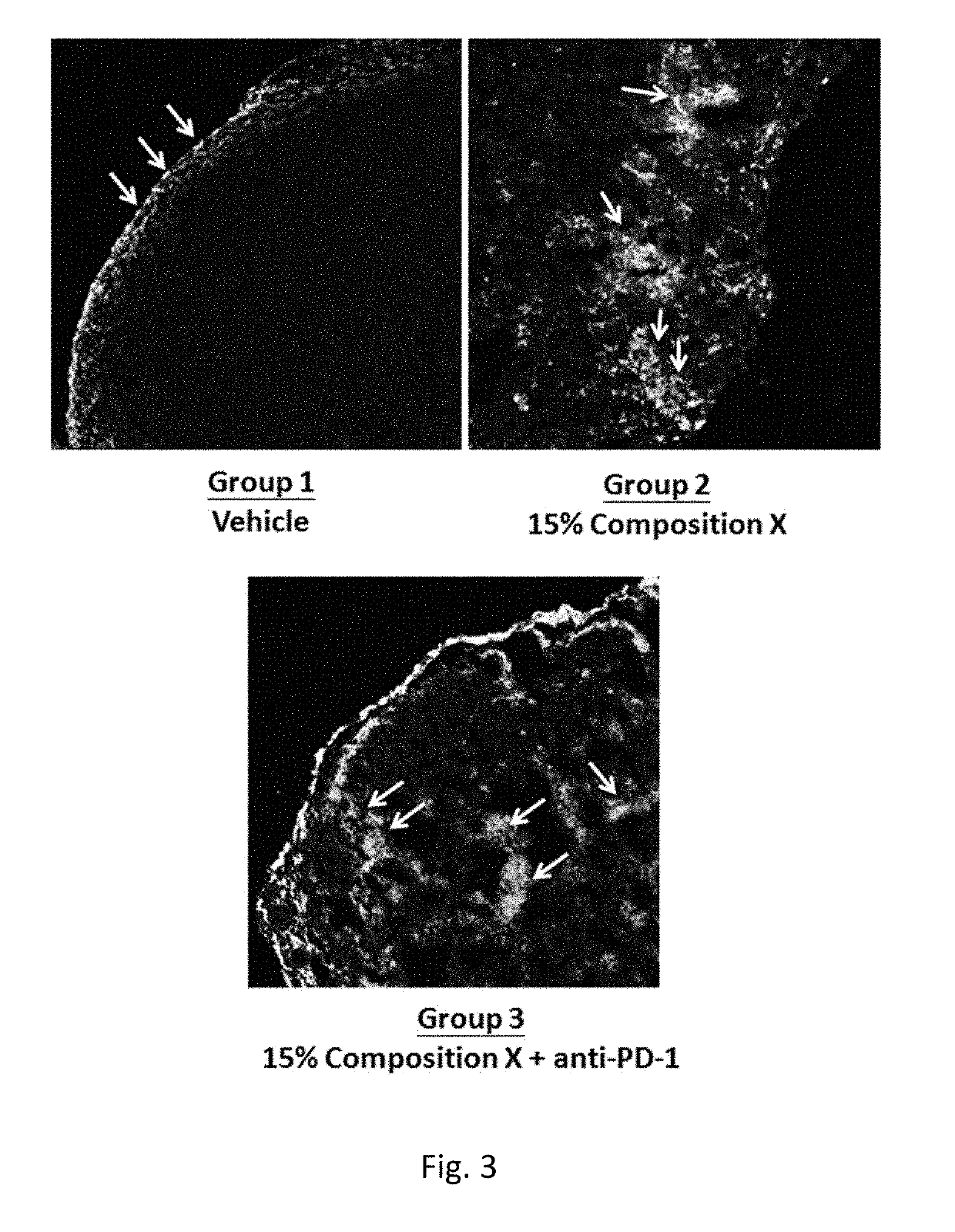Method of activating tumor-infiltrating lymphocytes (TILS)
- Summary
- Abstract
- Description
- Claims
- Application Information
AI Technical Summary
Benefits of technology
Problems solved by technology
Method used
Image
Examples
example 1
ion Products by Symbiotic Microbiota
[0081]Composition X is a fermented composition generated via fermentation of symbiotic microbiota in a medium. Briefly, symbiotic microbiota including Lactobacillus and yeast were cultured in a medium for fermentation containing carbon source, nitrogen source and trace elements, together with an aqueous soybean extract, under conditions that allow for fermentation by the microorganisms to generate suitable metabolites. The fermentation was conducted for about 24 to 72 hours. The fermented liquid were collected, filtered to remove solid materials, and sterilized. The liquid solution thus prepared was concentrated to produce Composition X (in liquid form). Each milligram of Composition X contains the fermented broth of about 2.7 g soybean. In separate fermentation, symbiotic microbiota including Lactobacillus, yeast and Lactococcus were used to generate additional fermentation products, Compositions LT12, LT17, LT21, LT23 and LT27.
example 2
n of Murine Bone Marrow Derived Dendritic Cells
[0082]At day 0, bone marrow (BM) was seeded at 2×106 cells per 100 mm dish in 9 ml RPMI-1640 medium containing 1% antibiotic-antimycotic, 10% FBS, 20 ng / ml rmGM-CSF. At day 3, another 9 ml RPMI-1640 medium containing 20 ng / ml rmGM-CSF were added to the plates. At day 8, BMDCs were plated in a density of 2×105 cells / mL resuspended in 1000 μL culture medium with 0.1 μg / mL LPS or various fermentation products (Compositions X, LT12, LT17, LT21, LT23, LT27) for 24 hours on 24-well plate in 5% CO2 / 95% air. After the treatment, cells were collected by gentle pipetting, centrifuged at 250 g for 5 min at room temperature. The cells were adjusted to a concentration of 1.5×105 cells / well in PBS with 0.5% FBS. Cell suspensions were incubated with antibodies for 30 min at 4° C. FITC-conjugated CD11c antibody, PE-conjugated CD83 antibody, were obtained from BD Biosciences. Flow cytometry analysis was performed with a FACSAria Fusion. The flow cytomet...
example 3
cer Mouse Model and Animal Tests
[0084]BALB / c mice were implanted subcutaneous (s.c.) with CT-26 2×105 cells on Day 0. Mice were randomized into treated or untreated groups (n=3 for each group) when the tumors volume reached 50 mm3 approximately on Day 4.
[0085]3.1 Treatment with Composition X
[0086]Mice were treated with 15% Composition X (10 mL / kg) by oral gavage daily from Day 4 to Day 11 for group 2 / 3. Mice were treated with ddH2O (10 mL / kg) by oral gavage daily from Day 4 to Day 11 for group 1. Mice were treated with anti-PD1 antibody at dose of 10 mg / kg by i.p. injection on Day 4, 6, 8 and 10 for group 3. Tumors volume was measured twice weekly. The survival rates were also determined. Mice were sacrificed on Day 11 for group 1 / 2 / 3 and tumors were collected.
[0087]3.2 Treatment with Composition LT12
[0088]Mice were treated with 15% Composition LT12 (10 mL / kg) by oral gavage daily until day 17. Mice were treated with ddH2O (Sterilized, 10 mL / kg) by oral gavage daily until day 17. Mi...
PUM
 Login to View More
Login to View More Abstract
Description
Claims
Application Information
 Login to View More
Login to View More - R&D
- Intellectual Property
- Life Sciences
- Materials
- Tech Scout
- Unparalleled Data Quality
- Higher Quality Content
- 60% Fewer Hallucinations
Browse by: Latest US Patents, China's latest patents, Technical Efficacy Thesaurus, Application Domain, Technology Topic, Popular Technical Reports.
© 2025 PatSnap. All rights reserved.Legal|Privacy policy|Modern Slavery Act Transparency Statement|Sitemap|About US| Contact US: help@patsnap.com



